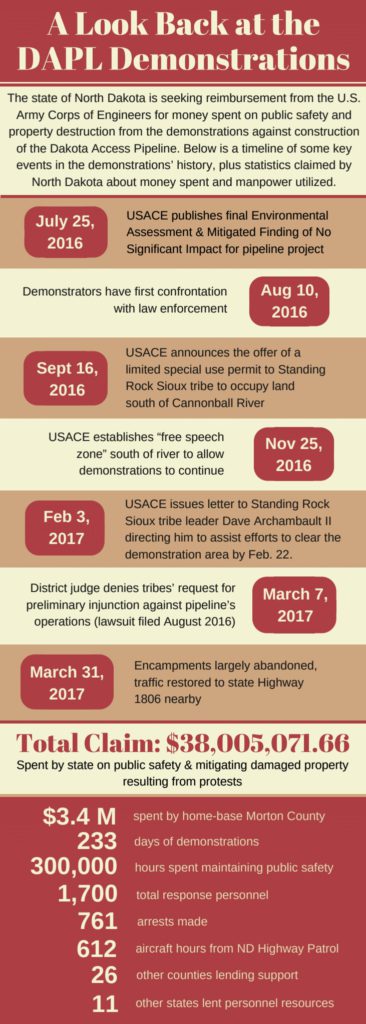

The state of North Dakota has filed notice of a federal tort claim against the U.S. Army Corps of Engineers for the USACE’s alleged failure in its duty to stop the Dakota Access Pipeline demonstrations in 2016 and 2017. The state has claimed more than $38 million in total damages, and a local Greenberg Traurig partner is serving as a special assistant attorney general to the state.
The Standing Rock demonstrations began in August 2016 and by the end of March 2017, the demonstrators had largely disbanded and vacated the encampments. The claim outlines key events that required particularly large amounts of law enforcement manpower and estimates about 1,700 total personnel were involved in the response at some point.
“This just blew [the people of North Dakota] away,” said partner Paul Seby, who serves as counsel to North Dakota, of the confrontational nature of the demonstrations. “That schools went on lockdown, and the state legislature was surrounded by protestors and not able to function for several days. It was just an overwhelming and really culturally shocking thing for them to see these protest camps where the vast majority of people who were in the camps were not from North Dakota.”
According to the claim, law enforcement made 761 arrests during the course of the demonstrations, and only 51 of those individuals lived in North Dakota.
The claim sets a period of six months for resolution and states North Dakota reserves the right to sue under the Federal Tort Claims Act after that period. Seby said the current notice, filed July 19, is an administrative claim rather than a complaint in federal court, which notifies the agency of the problem and provides it an opportunity to settle out of court.
In an email from a spokesperson, the U.S. Department of Justice declined to comment.
The claim alleges camps set up during the demonstrations were illegally located on federal land in North Dakota, and the USACE should have exercised its jurisdiction over its land to prevent or minimize the demonstrations and resulting property damage and public safety concerns. According to the claim, the USACE’s actions and inactions were “the direct and immediate cause of the dangerous and illegal civil unrest.”
North Dakota stepped in, rather than USACE, with a nearly eight-month public safety response in order to prevent deaths and protect property and public safety, the claim states.
“This state response eventually consumed thousands of ‘man days’ of law enforcement and first responder time and cost North Dakota $38,005,071.66,” states the claim.
Also included in the state’s total damages claim are reimbursements North Dakota made to 11 other states that lent their own law enforcement resources, such as Montana, South Dakota, Minnesota and further-away states including Alabama and Louisiana.
“This was not a budgeted event,” Seby said, adding there was no advance knowledge of the demonstrations’ occurrence or their magnitude. North Dakota has its own bank, but since it functions as a private bank, Seby said the state had to borrow money from itself and pay interest of nearly $10 million.
The claim states the spending also came at a particularly tough time when oil prices took a downturn and production slowed, which provides a major source of revenue for the state.
North Dakota’s claim points to the USACE’s failure to issue permits to the demonstrators as a piece of evidence of the Corps’ negligence, a requirement under its jurisdiction over the land it manages. The claim also states in September 2016, the USACE announced it had offered a limited special use permit to the Standing Rock Sioux tribe to occupy land south of the Cannonball River. But according to the claim, the permit was not issued because the tribe did not provide the USACE with the required bond to cover any damages resulting from the demonstrations.
“There’s no discretion for them to do that,” Seby said of the USACE’s duty to issue permits for the demonstrations. “And that’s important, because the Federal Tort Claims Act is a waiver of sovereign immunity against the federal government.”
The following November, according to the claim, the USACE sent a letter to Dave Archambault II, chair of the Standing Rock Sioux tribe, to tell the tribe the Corps was closing its lands north of the Cannonball river to protestors. The USACE established a “free speech zone” south of the river, but the claim contends the USACE knew the zone was not actually safer or better suited to emergency response services. The claim also stated the zone was not properly permitted because no sponsor ever obtained liability insurance and demonstrators continued dangerous and illegal activity.
Seby said before construction of the pipeline began, the project had gone through the necessary vetting and public comment process for approval by the USACE, but reiterated the Corps did not provide support to the state or take action to respond to the protests.
“When the federal government goes through those processes and the state’s involved in those processes, and then the federal government allows their lands to be used in a way that undermines all of that and inflicts a substantial public safety emergency, this is exactly what the Tort Claims Act was designed to address.”
—Julia Cardi

